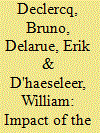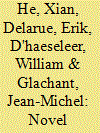|
|
|
Sort Order |
|
|
|
Items / Page
|
|
|
|
|
|
|
| Srl | Item |
| 1 |
ID:
128351


|
|
|
|
|
| Publication |
2014.
|
| Summary/Abstract |
The patchwork of different imbalance-settlement rules in geographically adjacent gas regions induces shippers to go "forum shopping" to minimize costs of ex-post balancing services. This shopping increases efficiency, and thus welfare of the shippers, on the one hand. The impact on net efficiency is dependent on the relative incentives provided by different balancing mechanisms and the relative system-balancing costs that the transmission-system operators face to offer balancing services to unbalanced shippers, on the other hand. If the gas-balancing mechanism and the system-balancing costs are aligned, net efficiency in the combined gas system will rise. Our results demonstrate that such an outcome is not guaranteed. Hence, market integration without properly checking compatibility of balancing rules can improve shipper efficiency at the cost of reducing overall efficiency. The latter outcome should clearly be avoided by policy makers and European regulators whose primary concern should be overall efficiency as this provides fair and efficient prices for gas consumers and a higher utility for society.
|
|
|
|
|
|
|
|
|
|
|
|
|
|
|
|
| 2 |
ID:
110581


|
|
|
|
|
| Publication |
2011,
|
| Summary/Abstract |
This paper analyzes the value and cost of line-pack flexibility in liberalized gas markets through examination of the techno-economic characteristics of gas transport pipelines and the trade-offs between different ways to use the infrastructure: transport and flexibility. Line-pack flexibility is becoming increasingly important as a tool to balance gas supply and demand over different periods. In the European liberalized market context, a monopolist unbundled network operator offers regulated transport services and flexibility (balancing) services according to the network code and balancing rules. Therefore, gas policy makers should understand the role and consequences of line-pack regulation. The analysis shows that the line-pack flexibility service has an important economic value for the shippers and the TSO. Furthermore, the analysis identifies distorting effects in the gas market due to inadequate regulation of line-pack flexibility: by disregarding the sunk costs of flexibility in the balancing rules, the overall efficiency of the gas system is decreased. Finally, the analysis demonstrates that the actual costs of line-pack flexibility are related to the peak cumulative imbalance throughout the balancing period. Any price for pipeline flexibility should, therefore, be based on the related trade-off between the right to use the line-pack flexibility and the provision of transport services
|
|
|
|
|
|
|
|
|
|
|
|
|
|
|
|
| 3 |
ID:
092730


|
|
|
|
|
| Publication |
2009.
|
| Summary/Abstract |
In order to combat global warming, a detailed knowledge of the greenhouse gas (GHG) emissions associated with different energy conversion technologies is important. For nuclear energy, GHG emissions result from different process stages of the whole fuel cycle. A life-cycle assessment offers the possibility to properly calculate these emissions. In the past, both indirect energy use and GHG emissions were studied by many researchers. Most of the studies result in low indirect emissions comparable to wind turbines. However, some of the studies in the literature obtain high results adding up to a significant fraction of the direct emissions from a CCGT.
In this paper, the GHG emissions resulting from the overall nuclear fuel cycle are analyzed by making a detailed comparison of the results from three different life-cycle assessments. Hereby, the studies are chosen in order to reflect the range of results available in open literature. The studies under consideration result in indirect emissions of around 8 and 58 g CO2/kWhe and more than 110 g CO2/kWhe.
An explanation is given for these strongly varying results by analyzing the input data, assumptions and estimations made for different process steps.
|
|
|
|
|
|
|
|
|
|
|
|
|
|
|
|
| 4 |
ID:
126600


|
|
|
|
|
| Publication |
2013.
|
| Summary/Abstract |
As of 2005, electricity generators in Europe operate under the European Union Emission Trading System (EU ETS). At the same time, European Member States have launched support mechanisms to stimulate the deployment of renewable electricity sources (RES-E). RES-E injections displace CO2 emissions within the sectors operating under the EU ETS and they reduce the demand for European Union Allowances (EUAs), thereby reducing the EUA price. This paper presents the results of an ex post analysis to quantify the impact of RES-E deployment on the EUA price and CO2 emissions in the Western and Southern European electricity sector during the period from 2007 to 2010, following from an operational partial equilibrium model of the electricity sector. This study shows that the CO2 displacement from the electricity sector to other ETS sectors due to RES-E deployment can be up to more than 10% of historical CO2 emissions in the electricity sector. The EUA price decrease caused by RES-E deployment turns out to be likely significant.
|
|
|
|
|
|
|
|
|
|
|
|
|
|
|
|
| 5 |
ID:
103469


|
|
|
|
|
| Publication |
2011.
|
| Summary/Abstract |
This paper investigates the impact of the economic recession on CO2 emissions in the European power sector, during the years 2008 and 2009. Three main determinants of the power sector's emissions are identified: the demand for electricity, the CO2 price, and fuel prices. A counterfactual scenario has been set up for each of these, i.e., what these parameters would have been if not affected by the recession. A simulation model of the European power sector is then employed, comparing a historical reference simulation (taking the parameters as actually occurred) with the counterfactual scenarios. The lower electricity demand (due to the recession) is shown to have by far the largest impact, accounting for an emission reduction of about 175 Mton. The lower CO2 price (due to the recession) resulted in an increase in emissions by about 30 Mton. The impact of fuel prices is more difficult to retrieve; an indicative reduction of about 17 Mton is obtained, mainly as a consequence of the low gas prices in 2009. The simulated combined impact of the parameters results in an emission reduction of about 150 Mton in the European power sector over the years 2008 and 2009 as a consequence of the recession.
|
|
|
|
|
|
|
|
|
|
|
|
|
|
|
|
| 6 |
ID:
103455


|
|
|
|
|
| Publication |
2011.
|
| Summary/Abstract |
Electricity storage is considered as a valuable source of flexibility with applications covering the whole electricity value chain. Most of the existing evaluation methods for electricity storage are conceived for one specific use of the storage, which often leads to the conclusion that the investment on storage does not pay off. However, the value of storage cannot be properly estimated without taking into account the possibility of aggregating the services that storage can offer to different actors. This paper proposes a new business model that allows aggregating multiple revenue streams of electricity storage in a systematic way. The model consists in coordinating a series of auctions in which the right to utilize the storage unit is auctioned upon different time horizons. In the mean time, non-conflicting usage of storage by the actors in these different auctions is ensured. The functioning of the model is demonstrated by a case study. The results show that a storage unit can achieve higher return on investment in the manner proposed in the business model.
|
|
|
|
|
|
|
|
|
|
|
|
|
|
|
|
|
|
|
|
|